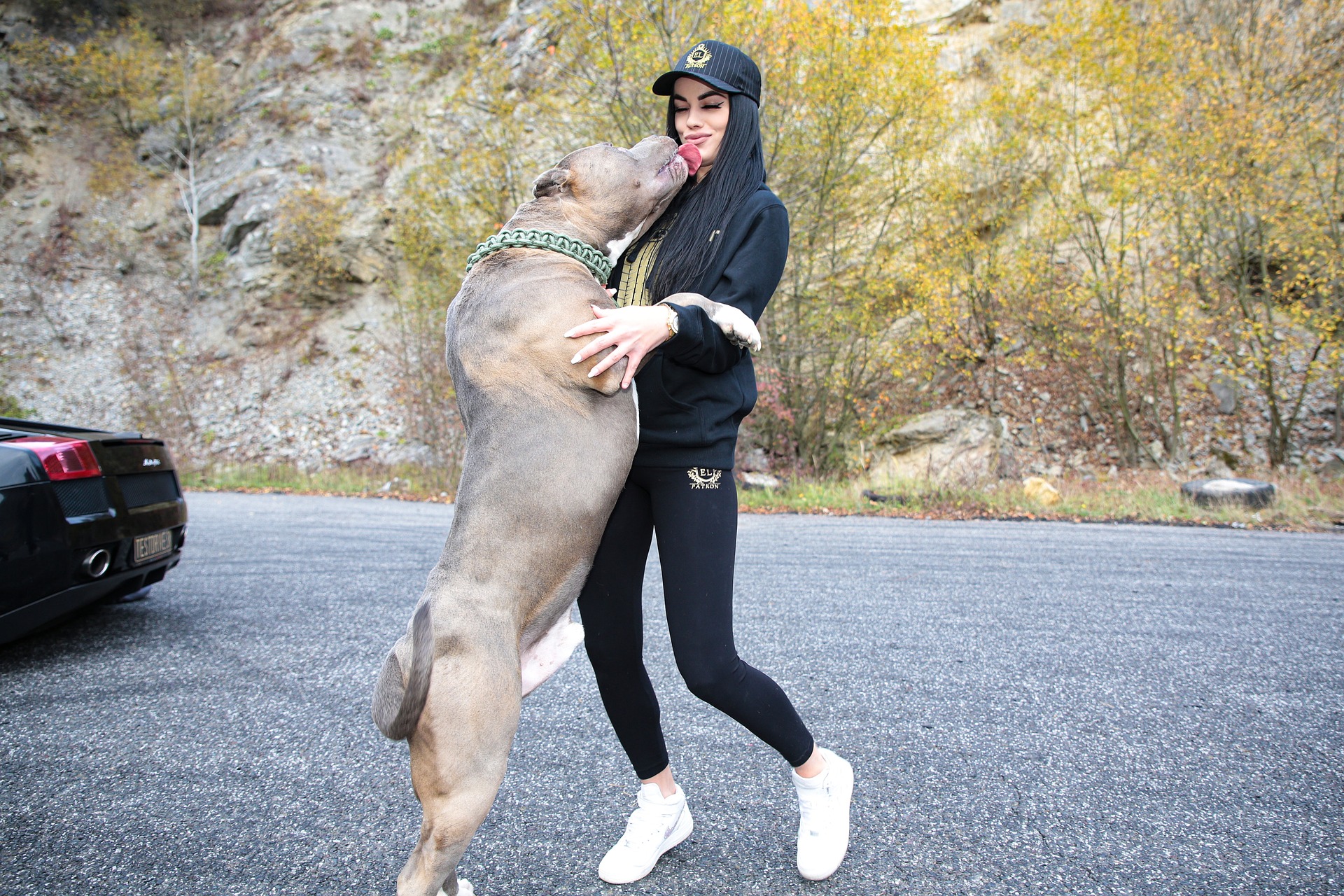Can dogs smell cancer cells in humans? The skin cells of the suspect had blown out the window, all along the side of the road. The dog tracked the epethelial cells right to the perpetrator. In short, yes, dogs are definitely capable of smelling cancer.
A dog’s nose is so finely tuned that he can smell as much as five-thousand times better than you can. A bloodhound once was able to track a suspect from the scene of a crime, along a highway for nearly twenty miles, straight to the car the suspect had parked at a hotel.
A schnauzer was trained at the University of Arizona to detect skin cancer. He was able to walk around the patient slowly and would sit when he smelled melanoma. The dog had a chilling 100% accuracy.
We’ve put the dog nose to work in many different fields, some of which include finding lost persons, even deceased ones, and looking for bombs at airports. Some dogs are taught to seek contraband fruits and vegetables as people are attempting to bring them to different countries or states where they could spread disease unintentionally.
Can They Really Detect Lung Cancer Inside Humans Though?

Research does seem to indicate that dogs can smell many types of cancer that might be inside the human body. Ways in which they can do this is to smell a urine sample or even smell the breath of the person being examined.
In fact, depending on the type of cancer, dogs can detect it in many various ways that include:
- Skin
- Breath
- Urine
- Feces
- Sweat
Dogs learn to trace the specific signature of odors, with specialized training that starts when they are puppies. Some adult dogs can also be trained successfully but most dogs start on scent-training work when they are very young.
An eight-week-old puppy can begin getting accustomed to the smell he is being trained to work with by having toys laced with the smells added to his environment and being rewarded when he interacts with them. Training gets more difficult as he gets older but it starts as early as possible.
A dog’s nose is so sensitive that they’ve been able to track a scent when it is diluted to one part per trillion. That means that if he is looking for one particular person by scent, and you had one skin cell of a trillion people, he’d find the correct person. Think about that and let it sink in. It’s incredible.
Medical Alert Dogs
This is the name given to dogs that taught to detect and alert to specific tests. These dogs can not just detect cancer. Some are trained to smell the chemical changes that tell them your blood sugar is too high or too low.
These same dogs can specialize in specific types of cancer, like the dog who worked to detect skin melanoma. Dogs have been trained and used to detect:
- Colorectal cancer (from breath or stool sample)
- Lung cancer (from breath)
- Ovarian cancer (from a blood sample)
- Prostate cancer (from urine sample)
A separate study also found that a dog that was specifically trained to determine when breast cancer was present, was also able to determine when either skin or lung cancers were present. This tells scientists that the scent markers of these odors are similar or the same.
Why Are More Dogs Not Used?
This is a good question. The dogs are low risk ways to determine if cancer is present. They aren’t invasive, meaning that you won’t require surgery. If you don’t like dogs or are allergic, it really won’t matter because the dog doesn’t have to smell you. They can smell a sample that you provide. This is a really wonderful way to use canines.
When there are so many dogs looking for homes in kennels everywhere, imagine the possibilities if we could train them all to be used in place of expensive lab tests? They could find better homes, you could have faster and less costly treatment, and doctors would get instant results. The dog only takes seconds to react to the smell.
Dogs are truly man’s best friend and there is a huge potential for this type of work. This would be a fantastic way of using dogs to help man even more than he already does. The costs of training dogs are not cheap but they’re also not nearly what it costs to run tests and pay for equipment. There are working medical alert dogs now and there will likely be more in the future.
Can Dogs Smell Cancer Samples With Diagnostic Accuracy?

When it comes to detecting diseases, humans have always relied on advanced medical technology and tests. However, did you know that our furry friends, dogs, have the remarkable ability to sniff out cancer cells in humans? Yes, it’s true! Dogs possess an incredibly powerful sense of smell, which allows them to detect even the faintest of scents, including the distinctive odor produced by breast cancer patients.
The concept of dogs being able to detect cancer blood in humans is not a new phenomenon. In fact, it dates back centuries, with anecdotal reports of dogs reacting differently to individuals who were later diagnosed with cancer. Recent scientific research has confirmed these observations, revealing that dogs have an impressive success rate in accurately diagnosing cancer through their sense of smell.
Type of Cancerous Samples That Canine Can Detect
Studies have shown that dogs can detect various types of cancer, including breast, lung, prostate, and colorectal cancer. With an accuracy rate as high as 98%, dogs could potentially serve as a valuable tool in early cancer detection and screening, offering a non-invasive and cost-effective approach to complement existing medical procedures.
Dogs have an incredible sense of smell that can detect various scents, including cancer. Studies have shown that they are capable of detecting certain types of cancer in humans by sniffing breath, urine, or tissue samples. This ability is being explored for early cancer detection and diagnosis.
Dogs have the potential to contribute to the development of less invasive and more affordable cancer screening methods. While more research is needed, their remarkable olfactory abilities offer promising possibilities in the field of cancer detection.
The Incredible Ability of Dogs: Detecting Cancer Cells in Humans
Dogs have long been recognized for their keen sense of smell and their ability to use it for various purposes, such as tracking scents, locating missing individuals, and detecting drugs or explosives. But did you know that dogs also have the extraordinary ability to detect cancer in humans? This remarkable skill has fascinated researchers and has led to promising advancements in cancer detection and diagnosis.
In recent years, there have been numerous anecdotes and research studies suggesting that dogs can detect breast cancer in humans with a high degree of accuracy. While the exact mechanism behind this ability is still not fully understood, it is believed to be linked to the unique olfactory system of dogs and their exceptional sense of smell.
The Science Behind Dogs’ Ability to Smell Healthy Cells Affected
Medical detection dogs possess a sense of smell that is significantly more powerful than that of humans. While humans have approximately 5 million olfactory receptors, dogs have about 220 million. This incredible number of receptors allows dogs to detect and distinguish a wide range of scents with remarkable precision.
Additionally, dogs have a specialized olfactory system that is specifically designed for scent detection. They have a larger vomeronasal organ, also known as the Jacobson’s organ, which is responsible for sensing pheromones and other volatile compounds. This organ enhances their ability to detect subtle scents and makes them highly sensitive to unique odors emitted by cancer.
When cancer proliferate in the body, they release certain volatile organic compounds (VOCs) that can escape through breath, sweat, urine, and other bodily fluids. These VOCs have unique odors that dogs can pick up, even at very low concentrations. By sniffing biological samples, such as breath or urine, dogs can identify the presence of these VOCs and signal the presence of cancer.
Research and Evidence of Dogs Detecting Cancer
Over the years, there have been several studies and case reports that have highlighted the astounding ability of dogs to detect lung cancer in humans. These studies have mainly focused on certain types of cancer, such as lung, breast, colorectal, and prostate cancer.
One notable study conducted at the Pine Street Foundation in California involved training five dogs to detect early-stage lung and breast cancers by sniffing breath samples. The results of the study showed that the dogs were able to accurately identify the presence of cancer in the samples, even at the early stages of the disease.
Another study published in the journal Gut demonstrated the remarkable ability of a Labrador Retriever trained to detect colorectal cancer in breath and stool samples. The dog was able to detect breast cancer with an accuracy rate of 91% for breath samples and 97% for stool samples.
These studies and many others provide compelling evidence that dogs can indeed detect cancer in humans, offering a potential non-invasive and cost-effective method for early detection and diagnosis.
Practical Applications of Canine Cancer Detection

The ability of dogs to detect breast cancer in humans has led to various practical applications in the field of medicine and cancer research. Here are a few notable examples:
Early Detection and Diagnostics
Dogs can potentially serve as an early detection tool for various types of cancer. By sniffing biological samples, they can identify the presence of cancer patients in the early stages of the disease, when treatment is most effective. This non-invasive and cost-effective method has the potential to revolutionize cancer screening and diagnostics.
Assistance in Cancer Research
Dogs can play a crucial role in cancer research by aiding scientists in understanding the specific odors emitted by cancer. By analyzing the VOCs detected by dogs, researchers can identify the unique chemical compounds associated with different types of cancer. This knowledge can contribute to the development of advanced diagnostic tools and treatments.
Training Cancer Detection Dogs
Due to their exceptional sense of smell, dogs can be trained to become cancer detection dogs. These specially trained dogs can be utilized in medical facilities to assist in cancer screening programs or to provide support in specific diagnostic procedures. Their ability to detect lung cancer can complement existing medical technologies and enhance detection efforts.
Challenges and Future Directions
While the idea of using dogs to detect breast cancer in humans is exciting, there are still several challenges that need to be addressed before this method can be widely implemented in medical settings.
One of the challenges is the reliability and consistency of results. While dogs have shown remarkable success in detecting cancer, there can be variations in their performance due to factors such as fatigue, distraction, or the presence of other odors that may interfere with their ability to smell cancer-specific odors.
Another challenge is the need for standardized training protocols and certifications for cancer detection dogs. It is essential to establish consistent guidelines and criteria for training these dogs and ensuring their accuracy and reliability in detecting cancer.
Despite these challenges, ongoing research continues to explore the potential of using dogs as cancer detection tools. Scientists are studying the chemical composition of VOCs emitted by cancer to develop electronic noses or other technologies that can mimic the exceptional olfactory abilities of dogs.
Key Takeaways
- Dogs have an incredible sense of smell that allows them to detect various diseases and conditions, including cancer.
- Research has shown that dogs can be trained to sniff out specific cancer or volatile organic compounds (VOCs) associated with cancer.
- Studies have demonstrated that dogs are able to detect early stages of cancer in humans with a high level of accuracy.
- The ability of dogs to identify cancer may be attributed to their highly sensitive noses, which contain over 200 million scent receptors.
- Dogs’ olfactory abilities have led to the development of canine cancer detection programs, where dogs are trained to assist in early cancer diagnosis.
Frequently Asked Questions
In this section, we will explore frequently asked questions about the ability of dogs to detect cancer in humans. Dogs have an incredible sense of smell, and there is growing evidence to suggest that they may be able to detect certain types of cancer. Let’s explore this fascinating topic further.
1. How can dogs detect cancer in humans?
Dogs have a remarkable sense of smell that allows them to detect even the slightest changes in the chemical composition of the human body. When cancer are present, the body releases certain volatile organic compounds that have a distinct odor. These odors can be detected by dogs, who can be trained to recognize and alert to them through scent detection training.
Through their keen sense of smell, dogs can identify the specific scent associated with cancer and differentiate it from healthy cells. Studies have shown that dogs have the ability to detect a variety of cancers, including lung, breast, colorectal, and prostate cancer.
2. What are the benefits of using dogs to detect cancer cells?
The use of dogs to detect cancer in humans has several potential benefits. Firstly, dogs have the ability to smell lung cancer blood at an early stage, even before it becomes symptomatic or detectable through traditional screening methods. This detection can lead to earlier intervention and potentially better treatment outcomes.
Additionally, using dogs for cancer detection is non-invasive and painless for the patient. There are no needles or scans involved, making it a less stressful and more comfortable experience. Moreover, it is a cost-effective method compared to some of the current diagnostic techniques.
3. How accurate are dogs at canine olfactory detection?
While dogs have shown promising results in canine scent detection, it’s important to note that they are not infallible. The accuracy of their detection can vary depending on several factors, including the individual dog’s training, the specific type of cancer being detected, and the conditions in which the detection is taking place.
Some studies have reported high levels of accuracy, with dogs correctly identifying cancer in a significant number of cases. However, further research is still needed to fully understand the limitations and potential of using dogs as a diagnostic tool for cancer.
4. How are dogs trained to detect cancer cells?
To train dogs to detect lung cancer, a process known as scent detection training is used. This involves exposing the dogs to samples of cancer and teaching them to recognize and indicate the presence of these cells through specific behaviors, such as sitting or pawing.
During training, dogs are rewarded for correctly identifying the cancer and alerted to the specific scent associated with cancer. This process is repeated until the dogs are consistently able to detect the scent and alert their handlers to its presence.
5. Can dogs detect cancer in other animals besides humans?
Yes, dogs have also shown the ability to detect cancer in other animals, including but not limited to dogs themselves. This suggests that the scent associated with cancer is not species-specific and can be recognized by dogs regardless of the host organism.
Research into using dogs as a diagnostic tool for cancer detection in animals is still ongoing, but the initial findings are promising. This could have implications for veterinary medicine, as well as for understanding the underlying mechanisms of cancer detection through scent.
In conclusion, numerous studies have shown that dogs have the ability to detect cancer in humans through their highly developed sense of detecting lung cancer. Dogs have been trained to identify specific cancer types, such as lung, breast, and prostate cancer, by sniffing breath, urine, or tissue samples.
This remarkable ability is attributed to the volatile organic compounds (VOCs) emitted by cancer, which dogs can detect even at low concentrations. While more research is needed to fully understand the mechanism behind this phenomenon, the use of dogs in cancer detection could potentially lead to earlier diagnosis and improved treatment outcomes.
Conclusion
The ability of dogs to detect cancer in humans is a remarkable phenomenon that holds significant potential for improving cancer detection and diagnosis. While further research and standardization are necessary, the findings thus far are promising and suggest that dogs can indeed contribute to detection efforts and advancements in cancer research.
Last Updated on 16/03/2025 by Karen Snow
Hi! I’m Karen and a certified dog lover. As a freelance writer and blogger, I do my best to squeeze in some time with my dogs, learning more about the way they act and how I can make sure that they continue to stay well-cared for by yours truly.
My dogs have helped me through a lot, and this is my way of giving back to them! Besides animals, I also love to travel and cook, having explored my country’s restaurants and unique places. Follow me as I show you all the amazing tips and bits of information I learn along the way about our furry friends!
